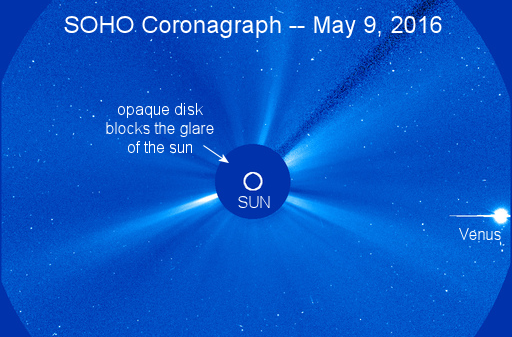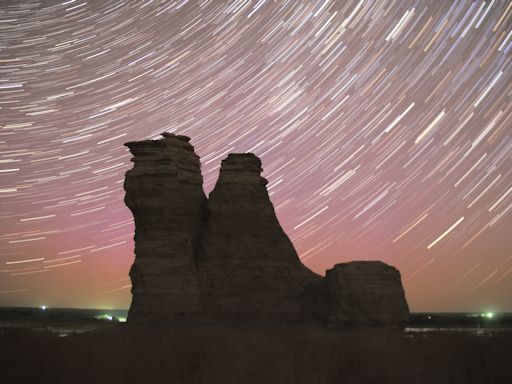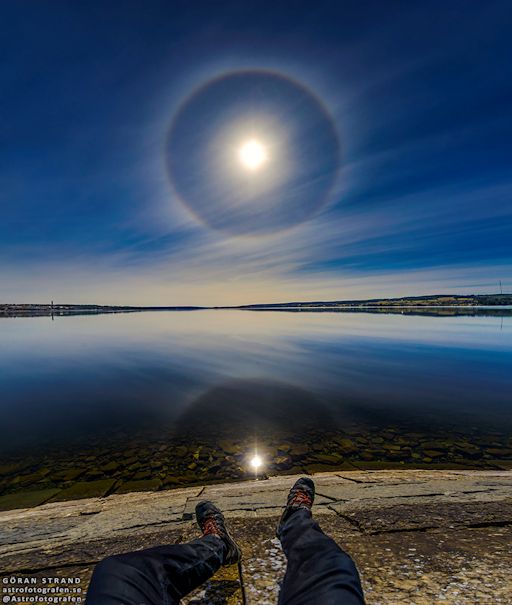On May 9th, the planet Mercury will pass in front of the sun, producing an inky-black spot on the solar disk. Catch it live on the Internet, courtesy of the Coca-Cola Space Science Center in Columbus, Georgia. | | | LONG RANGE FORECAST: Geomagnetic activity is expected to remain low for the rest of the week. The next storms are possible on May 16th when Earth enters a stream of solar wind flowing from a coronal hole on the sun. High-latitude sky watchers should be alert for auroras at that time. Aurora alerts: text, voice. SUPERIOR CONJUNCTION OF VENUS: Looking for Venus? Don't. You will only hurt your eyes. This month Venus is uncomfortably close to the sun. It soars overhead at local noon less than 7o away from the blinding solar disk. The Solar and Heliospheric Observatory (SOHO) is monitoring the close encounter using an opaque disk to block the glare: 
As seen from Earth, Venus will remain close to the sun for the next month and a half. A coronagraph such as the one on SOHO will be required to track the planet during this time. Dates of special interest include May 24th, when Venus, the sun, and the Pleiades star cluster form a triangle in the SOHO field of view, and June 6th, when Venus passes directly behind the body of the sun. Astronomers call the latter a "superior conjunction of Venus." Still looking for Venus? Here it is. Realtime Space Weather Photo Gallery LOW LATITUDE AURORAS: On May 8th, the strongest geomagnetic storm of 2016 erupted when Earth entered a region of space filled with negative polarity magnetic fields. During the G3-class event, Northern Lights spilled across the Canadian border into the United States, descending to latitudes where auroras are rare indeed. Terrence Cook photographed the colorful glow of the storm from Kansas: 
"After witnessing two tornadoes near Wray, Colorado, I continued driving east towards Colby, Kansas, when I noticed the aurora dancing over lightning to the north!" says Cook. "I stopped at Castle Rock for a photo shoot." The auroras were barely visible to the naked eye, but they were an easy target for Cook's camera when he opened the shuttler for a long exposure. Even further south, Brian Emfinger photographed the red rays of the geomagnetic storm from Arkansas: image. These are sometimes called "deep sky auroras" because they require photo settings akin to those used for faint objects like galaxies and nebulas. Challenge to low-latitude astrophotographers: The next time there's a strong geomagnetic storm, open your shutters. The results may surprise you. Aurora alerts: text, voice.
Realtime Space Weather Photo Gallery HANGING OUT WITH SUN HALOS: Northern summer is just weeks away. For people near the Arctic Circle, that means its time to absorb some long-overdue sunlight--or in this case, a sun halo: 
"Today, I've been hanging out with a beautiful reflected solar halo, the first halo for this summer season," says photographer Göran Strand of Östersund, Sweden. Sun halos are caused by ice in high cirrus clouds. When sunlight refracts through hexagonal crystals, it forms a 22-degree ring of light as shown above. These crystals are present even during summer because the air 10 km high is always cold enough to freeze water. The northern sun has risen. Let the hanging out begin! Realtime Space Weather Photo Gallery
Realtime Aurora Photo Gallery
Mercury Transit Photo Gallery
Realtime Comet Photo Gallery Every night, a network of NASA all-sky cameras scans the skies above the United States for meteoritic fireballs. Automated software maintained by NASA's Meteoroid Environment Office calculates their orbits, velocity, penetration depth in Earth's atmosphere and many other characteristics. Daily results are presented here on Spaceweather.com. On May. 11, 2016, the network reported 15 fireballs.
(12 sporadics, 3 eta Lyrids)  In this diagram of the inner solar system, all of the fireball orbits intersect at a single point--Earth. The orbits are color-coded by velocity, from slow (red) to fast (blue). [Larger image] [movies] Potentially Hazardous Asteroids ( PHAs) are space rocks larger than approximately 100m that can come closer to Earth than 0.05 AU. None of the known PHAs is on a collision course with our planet, although astronomers are finding new ones all the time. On May 11, 2016 there were potentially hazardous asteroids. Notes: LD means "Lunar Distance." 1 LD = 384,401 km, the distance between Earth and the Moon. 1 LD also equals 0.00256 AU. MAG is the visual magnitude of the asteroid on the date of closest approach. | | Cosmic Rays in the Atmosphere | | Situation Report -- Oct. 30, 2015 | Stratospheric Radiation (+37o N) | | Cosmic ray levels are elevated (+6.1% above the Space Age median). The trend is flat. Cosmic ray levels have increased +0% in the past month. | | Sept. 06: 4.14 uSv/hr (414 uRad/hr) | | Sept. 12: 4.09 uSv/hr (409 uRad/hr) | | Sept. 23: 4.12 uSv/hr (412 uRad/hr) | | Sept. 25: 4.16 uSv/hr (416 uRad/hr) | | Sept. 27: 4.13 uSv/hr (413 uRad/hr) | | Oct. 11: 4.02 uSv/hr (402 uRad/hr) | | Oct. 22: 4.11 uSv/hr (411 uRad/hr) | These measurements are based on regular space weather balloon flights: learn more. Approximately once a week, Spaceweather.com and the students of Earth to Sky Calculus fly "space weather balloons" to the stratosphere over California. These balloons are equipped with radiation sensors that detect cosmic rays, a surprisingly "down to Earth" form of space weather. Cosmic rays can seed clouds, trigger lightning, and penetrate commercial airplanes. Our measurements show that someone flying back and forth across the continental USA, just once, can absorb as much ionizing radiation as 2 to 5 dental X-rays. For example, here is the data from a flight on Oct. 22, 2015: 
Radiation levels peak at the entrance to the stratosphere in a broad region called the "Pfotzer Maximum." This peak is named after physicist George Pfotzer who discovered it using balloons and Geiger tubes in the 1930s. Radiation levels there are more than 80x sea level. Note that the bottom of the Pfotzer Maximim is near 55,000 ft. This means that some high-flying aircraft are not far from the zone of maximum radiation. Indeed, according to the Oct 22th measurements, a plane flying at 45,000 feet is exposed to 2.79 uSv/hr. At that rate, a passenger would absorb about one dental X-ray's worth of radiation in about 5 hours. The radiation sensors onboard our helium balloons detect X-rays and gamma-rays in the energy range 10 keV to 20 MeV. These energies span the range of medical X-ray machines and airport security scanners. | | The official U.S. government space weather bureau | | | The first place to look for information about sundogs, pillars, rainbows and related phenomena. | | | Researchers call it a "Hubble for the sun." SDO is the most advanced solar observatory ever. | | | 3D views of the sun from NASA's Solar and Terrestrial Relations Observatory | | | Realtime and archival images of the Sun from SOHO. | | | from the NOAA Space Environment Center | | | the underlying science of space weather | | 
